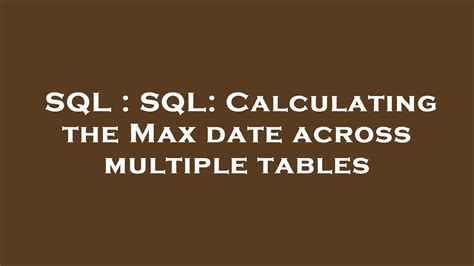When working with databases or datasets, selecting the maximum date from a collection of dates is a common requirement. This operation is crucial for various applications, such as data analysis, reporting, and updating records based on the most recent information. There are multiple ways to achieve this, depending on the database management system (DBMS) or programming language you are using. Below, we will explore five different methods to select the maximum date, covering SQL, Python, JavaScript, and more, to provide a comprehensive understanding of how to approach this task in different contexts.
Understanding the Problem

Before diving into the solutions, it’s essential to understand the problem clearly. Selecting the maximum date involves comparing a set of dates and identifying the most recent one. This could be a straightforward query in a database or a few lines of code in a programming language. However, the exact implementation can vary significantly based on the tools and technologies being used.
Method 1: Using SQL
In SQL, selecting the maximum date from a table can be achieved using the MAX function. This function returns the highest value in a set of values. When applied to date fields, it returns the most recent date. Here’s a basic example:
SELECT MAX(date_column) AS max_date
FROM your_table;
This query will return the most recent date stored in `date_column` of `your_table`. SQL is a powerful language for managing relational databases, and this query can be adapted to fit more complex scenarios by adding conditions with `WHERE` or combining with other queries.
Method 2: Using Python
In Python, you can select the maximum date from a list of dates using the max function with a list of datetime objects. Here’s how you can do it:
from datetime import datetime
# List of dates
dates = [
datetime(2022, 1, 1),
datetime(2022, 6, 15),
datetime(2022, 12, 31)
]
# Find the maximum date
max_date = max(dates)
print(max_date)
This Python code defines a list of dates and then uses the built-in `max` function to find the most recent date, which is then printed out. Python is versatile and can be used for a wide range of applications, from data analysis to web development.
Method 3: Using JavaScript
In JavaScript, you can find the maximum date from an array of dates using the reduce method or by converting the dates to timestamps and comparing them. Here’s an example using the reduce method:
const dates = [
new Date('2022-01-01'),
new Date('2022-06-15'),
new Date('2022-12-31')
];
const maxDate = dates.reduce((a, b) => a > b? a : b);
console.log(maxDate);
This JavaScript code creates an array of dates and then uses the `reduce` method to compare each date and find the maximum one, which is logged to the console. JavaScript is commonly used for client-side scripting on the web but is also used in mobile, game, and desktop application development.
Method 4: Using Pandas (Python Library)
Pandas is a powerful Python library used for data manipulation and analysis. If you have a DataFrame with a date column, you can find the maximum date as follows:
import pandas as pd
# Sample DataFrame
data = {
'Date': ['2022-01-01', '2022-06-15', '2022-12-31']
}
df = pd.DataFrame(data)
# Convert 'Date' column to datetime
df['Date'] = pd.to_datetime(df['Date'])
# Find the maximum date
max_date = df['Date'].max()
print(max_date)
This example demonstrates how to create a DataFrame, convert a column to datetime format, and then find the maximum date in that column using Pandas. Pandas is particularly useful for data analysis and scientific computing.
Method 5: Using Excel
In Microsoft Excel, you can find the maximum date in a range of cells using the MAX function. The formula is straightforward:
=MAX(range)
For example, if your dates are in cells A1 through A10, you would use:
=MAX(A1:A10)
This formula returns the most recent date in the specified range. Excel is widely used for data storage, analysis, and visualization, and its formulas provide a simple way to perform calculations like finding the maximum date.
Key Points
- The method for selecting the maximum date depends on the context, such as the DBMS or programming language being used.
- SQL's `MAX` function is useful for database queries.
- Python's `max` function can be used for lists of datetime objects.
- JavaScript's `reduce` method can compare dates in an array.
- Pandas provides an efficient way to find the maximum date in a DataFrame.
- Excel's `MAX` function is handy for spreadsheet calculations.
What is the most efficient way to select the maximum date in a large dataset?
+The most efficient way often involves using built-in functions or methods provided by the database system or programming language, as these are optimized for performance.
How do I handle missing or invalid dates when trying to find the maximum date?
+Handling missing or invalid dates typically involves cleaning the data before finding the maximum date. This can include filtering out invalid dates or using specific functions that ignore non-date values.
Can I use these methods for finding the minimum date as well?
+Yes, the methods for finding the minimum date are similar, often involving the use of a `MIN` function instead of `MAX` in SQL, Excel, and other contexts, or using comparable methods in programming languages.
In conclusion, selecting the maximum date from a set of dates is a fundamental operation that can be performed in various ways, depending on the tools and technologies at your disposal. Whether you are working with databases, programming languages, or spreadsheet software, understanding how to efficiently find the most recent date is crucial for data analysis, reporting, and decision-making.
